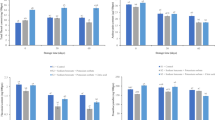Abstract
The aim of this study was to evaluate the physicochemical, antioxidant (antioxidant activity, total phenolic compounds, flavonoids, anthocyanins), and sensory characteristics of fresh (FRJ) and fermented (FEB) pomegranate beverages. Three fermentation conditions were tested based on the total soluble solids (TSS: °Bx) content in pomegranate juice: (a) natural TSS (13.9 °Bx) in fresh juice (FEB1), (b) adjusted to 17.5 °Bx (FEB2) and (c) adjusted to 25 °Bx (FEB3). The antioxidant activity, total phenolic compounds, flavonoids and anthocyanins after fermentation in FEB3 were 262.61 ± 0.12 mg Trolox, 188.60 ± 0.20 mg Gallic acid, 64.35 ± 0.09 mg quercetin and 1.92 ± 0.15 cyanidin-3-O-glucoside (C3OG)/100 mL, respectively. The final amounts of ethanol in FEB1, FEB2, and FEB3 were 6.82 ± 0.01, 9.73 ± 0.01, and 12.88 ± 0.01% (v/v), similar to that in wines. In general, the sensory characteristics of both FRJ and FEB beverages were well sensory accepted by consumers.
Similar content being viewed by others
References
AOAC (2000) Official methods of analysis. Association of Analytical Chemist. Inc., Washington
Baqueiro-Peña I, Guerrero-Beltrán JA (2017) Physicochemical and antioxidant characterization of Justicia spicigera. Food Chem 218:305–312
Berenguer M, Vegara S, Barrajón E, Saura D, Valero M, Martí N (2016) Physicochemical characterization of pomegranate wines fermented with three different Saccharomyces cerevisiae yeast strains. Food Chem 190:848–855
Brand-Williams W, Cuvelier ME, Berset C (1995) Use of a free radical method to evaluate antioxidant activity. LWT-Food Sci Technol 28(1):25–30
Çam M, Hışıl Y, Durmaz G (2009) Classification of eight pomegranate juices based on antioxidant capacity measured by four methods. Food Chem 112(3):721–726
Dewanto V, Wu X, Adom KK, Liu RH (2002) Thermal processing enhances the nutritional value of tomatoes by increasing total antioxidant activity. J Agric Food Chem 50(10):3010–3014
DGN (2014) NOM-142-SSA1/SCFI-2014, Bebidas alcohólicas. Especificaciones sanitarias. http://www.dof.gob.mx/nota_detalle.php?codigo=5386313&fecha=23/03/2015. Accessed 13 Dec 2017
Goldner MC, Zamora MC, Di Leo Lira P, Gianninoto H, Bandoni A (2009) Effect of ethanol level in the perception of aroma attributes and the detection of volatile compounds in red wine. J Sens Stud 24(2):243–257
El Kar C, Ferchichi A, Attia F, Bouajila J (2011) Pomegranate (Punica granatum) juices: chemical composition, micronutrient cations, and antioxidant capacity. J Food Sci 76(6):C795–C800
García BC, Pérez VA (2004) La granada. Alimento rico en polifenoles antioxidantes y bajo en calorías. Alimentación, Nutrición y Salud 11(4):113–120
Gil MI, Tomás-Barberán FA, Hess-Pierce B, Holcroft DM, Kader AA (2000) Antioxidant activity of pomegranate juice and its relationship with phenolic composition and processing. J Agric Food Chem 48(10):4581–4589
Giusti MM, Wrolstad RE (2001) Characterization and measurement of anthocyanins by UVvisible spectroscopy. In: Wrolstad RE (ed) Current protocols in food analytical chemistry. Wiley, New York, pp F.1.2.1–F.1.2.13
Gumienna M, Szwengiel A, Górna B (2016) Bioactive components of pomegranate fruit and their transformation by fermentation processes. Eur Food Res Technol 242(5):631–640
International Code of Oenological Practices (2015) Annex maximum acceptable limits. http://www.oiv.int/public/medias/3741/e-code-annex-maximum-acceptable-limits.pdf. Accessed 11 Dec 2017
Lantzouraki DZ, Sinanoglou VJ, Tsiaka T, Proestos C, Zoumpoulakis P (2015) Total phenolic content, antioxidant capacity and phytochemical profiling of grape and pomegranate wines. RSC Adv 5(123):101683–101692
Marcus RT (1998) The measurement of color. In: Nassau K (ed) Color for science, art and technology. Elsevier, Amsterdam, pp 31–39
Mena P, Gironés-Vilaplana A, Martí N, García-Viguera C (2012) Pomegranate varietal wines: phytochemical composition and quality parameters. Food Chem 133(1):108–115
Ordoudi SA, Mantzouridou F, Daftsiou E, Malo C, Hatzidimitriou E, Nenadis N, Tsimidou MZ (2014) Pomegranate juice functional constituents after alcoholic and acetic acid fermentation. J Funct Foods 8:161–168
Poyrazoglu E (2002) Organic acids and phenolic compounds in pomegranates grown in (Punica granatum L.) Turkey. J Food Compos Anal 15(5):567–575
Sepúlveda E, Sáenz C, Peña A, Robert P, Bartolomé B, Gómez-Cordovés C (2010) Influence of the genotype on the anthocyanin composition, antioxidant capacity and color of Chilean pomegranate (Punica granatum L.) juices. Chil J Agric Res 70(1):50–57
SIAP (Servicio de Información Agroalimentaria y Pesquera) (2014) http://www.siap.gob.mx/cierre-de-la-produccion-agricola-por-cultivo/. Accessed 1 Dec 2017
Singleton VL, Orthofer R, Lamuela-Raventos RM (1999) Analysis of total phenols and other oxidation substrates and antioxidants by means of Folin–Ciocalteu reagent. Methods Enzymol 299:152–178
Tehranifar A, Zarei M, Nemati Z, Esfandiyari B, Vazifeshenas MR (2010) Investigation of physico-chemical properties and antioxidant activity of twenty Iranian pomegranates (Punica granatum L.) cultivars. Sci Hortic 126(2):180–185
Tzulker R, Glazer I, Bar-IIan I, Holland D, Aviram M, Amir R (2007) Antioxidant activity, polyphenol content, and related compounds in different fruit juices and homogenates prepared from 29 different pomegranate accessions. J Agric Food Chem 55(23):9559–9570
Van Elswijk DA, Schobel UP, Lansky EP, Irth H, Van Der Greef J (2004) Rapid dereplication of estrogenic compounds in pomegranate (Punica granatum) using on-line biochemical detection coupled to mass spectrometry. Phytochem 65(2):233–241
Wichchukit S, O’Mahony M (2015) The 9-point hedonic scale and hedonic ranking in food science: some reappraisals and alternatives. J Sci Food Agric 95(11):2167–2178
Zarei M, Azizi M, Bashir-Sadr Z (2011) Evaluation of physicochemical characteristics of pomegranate (Punica granatum L.) fruit during ripening. Fruits 66:121–129
Zhuang H, Du J, Wang Y (2011) Antioxidant capacity changes of 3 cultivar Chinese pomegranate (Punica granatum L.) juices and corresponding wines. J Food Science 76(4):C606–C611
Acknowledgements
Gabriela Rios-Corripio thanks to Universidad de las Américas Puebla (UDLAP) for the scholarship granted to complete her doctoral studies.
Author information
Authors and Affiliations
Corresponding author
Rights and permissions
About this article
Cite this article
Rios-Corripio, G., Guerrero-Beltrán, J.Á. Antioxidant and physicochemical characteristics of unfermented and fermented pomegranate (Punica granatum L.) beverages. J Food Sci Technol 56, 132–139 (2019). https://doi.org/10.1007/s13197-018-3466-6
Revised:
Accepted:
Published:
Issue Date:
DOI: https://doi.org/10.1007/s13197-018-3466-6




